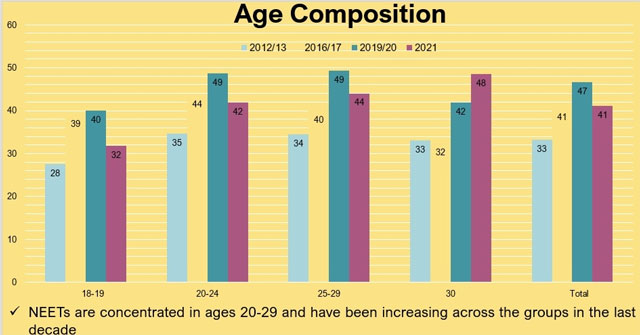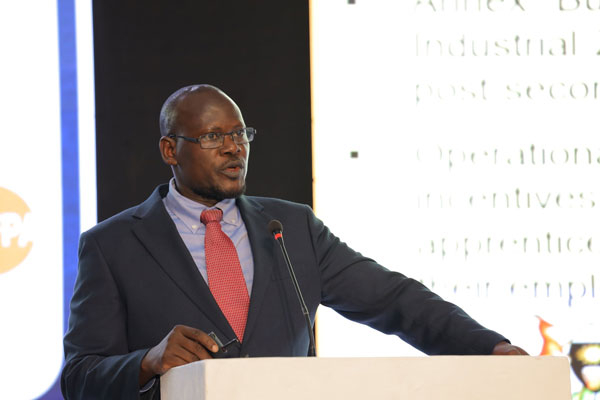







Kampala, Uganda | THE INDEPENDENT | A recent report from the National Planning Authority (NPA) has revealed that 4.2 million youths in Uganda are ‘Neither in Employment, Education, nor Training- NEETs, representing 41 percent of the country’s younger population.
In addition to high unemployment rates, young people aged 18 to 29 are consistently disengaged from the labor market, education, training, and broader societal activities.
Despite Uganda’s economy generating 1.6 million jobs between 2016 and 2021, a significant number of youths struggle to secure employment or create their own opportunities. This has led to an increase in the unemployment rate from 13 percent to 16.5 percent. The NEETs population has been increasing at a rate of 8.4 percent over the past decade, raising the number from 2.5 million to the current 4.2 million. It is projected to increase to 5.8 million in 2031/32 if nothing changes.
Furthermore, the report indicates that NEETs numbers are distributed according to regional poverty levels in the country.
Higher concentrations of NEETs are in Bukedi (61.4 percent), Lango (49.3 percent), Elgon (44.1 percent), Busoga (43.5 percent), Bunyoro (42.5 percent), and Kigezi (42.1 percent). The majority of them are unskilled (58 percent), from large poor rural households, disabled, substance abusers, and mostly between 25 to 27 years old.
During the launch of this report in Kampala on Tuesday, Hamis Mugendawala, the NPA manager for policy research, noted that NEETs are a result of a number of factors that need urgent attention. Most of them drop out of school in or immediately after primary five. “Many youth NEETs leave school early due to a lack of funds, and being female is associated with being NEET, as they give up school or work due to gender roles society attaches to them.

The socioeconomic status of one’s family is also a major determinant. Those from richer households are less likely to become NEETs (27 percent), whereas those with a poor background have a 60 percent chance,” Mugendawala said. According to Mugendawala, NEETs are a significant economic loss to the country, affecting personal incomes, households, and communities, and transcending to affect the nation’s GDP.
This report comes at a time when the country has aggressively invested in youth empowerment and development interventions, but Mugendawala notes that, with an average of 297,042 jobs annually, agriculture stands as the primary source of jobs in the country.
These could also suit most of the NEETs’ skill sets, but they were reluctant to join due to unguaranteed financial returns, hence preferring economic activities like sand mining, stone quarrying, and the like, with at least a guaranteed daily income. Whereas those interested in agriculture faced limitations, starting with land ownership. The NEETs also face barriers to reskilling, which could help them enter the labor market.
Mugendawala mentions that these barriers are mainly financial and structural. What seems to be working for the NEETs is the Presidential Industrial Zonal Skilling Hubs, but they also have limitations.
Meanwhile, Martin Wandera, the director for labor, employment, and occupational safety and health at the Ministry of Gender, Labour, and Social Development, disputed the report, stating that 4.2 million youth is such a big number. He suggests the report should be revised to align with updated statistics from the Ministry of Gender.
He adds that the report excluded a number of vital parameters like housewives and working-age variations, which could have been considered if the report was to be more comprehensive. According to Wandera, the NEETs’ numbers are about 2.5 million when all the required factors and categorizations are considered, bringing the concern to 24 percent rather than 41 percent.
****
URN
 The Independent Uganda: You get the Truth we Pay the Price
The Independent Uganda: You get the Truth we Pay the Price




Parliament found how to manage the gays yet they have failed to manage NEETs? We need an anti-NEET bill so that these NEETs can go to prison and they do nothing from there until they get fed up of doing nothing. At least they can benefit from skills development programs offered to prisoners. Do they still take prisoners to dig on big people’s farms? That’s better than doing nothing.
U need to first analyse critically the factors leading those youths into that social status before you come up with that kind of uninformed conclusion.